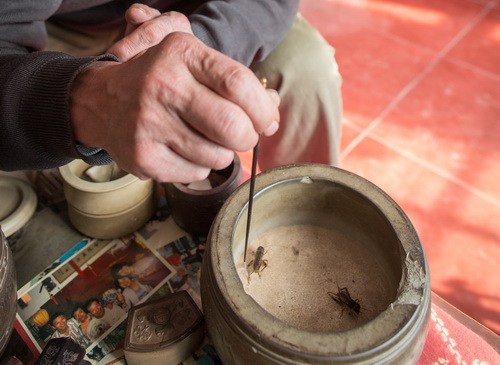Here is the typical process of self providing rice:
 Villagers of Law Uk Tseun will first throw all of the seeds in shallow water with soil underneath.Once the seeds have grown a significant amount as shown in the first picture then they are all pulled out and placed separately in a another piece of land with also a small amount of water for the plant to continue to grow. This is all done by hand through the villagers. These plants will continue to grow for around 6-8 months depending on the weather until the reach the stage here they look similar to wheat in which villages will also hand-pick out of the plants.
Villagers of Law Uk Tseun will first throw all of the seeds in shallow water with soil underneath.Once the seeds have grown a significant amount as shown in the first picture then they are all pulled out and placed separately in a another piece of land with also a small amount of water for the plant to continue to grow. This is all done by hand through the villagers. These plants will continue to grow for around 6-8 months depending on the weather until the reach the stage here they look similar to wheat in which villages will also hand-pick out of the plants. |
| "Rice Separator" |
These bunches of rice that look like wheat are then separated from their stems by being constantly hit against a pot as shown in the picture on the left. This is continuously done by a villager until all the piece of rice are separated from the stems. The leftover stem is then roasted and dried out in the sun and is soon used as fodder to feed cows and other bigger animals. The rice in the pot is also dried out in the sun ready for the next step in the process.
 The dried out rice is the placed in a
The dried out rice is the placed in amachine like the one on the left. In this case, the entire Law Uk Tseun only had one of these machines placed in the community temple to share between the 18 neighbors. The process of this is that the rice is poured into the machine from the topped whilst someone is personally turning the handle for the turbine wheel. The machine will then help to separate the rice into three parts; the completely bad rice that cannot be eaten, the rice that is considered 'okay' and the rice that is of best quality. The bad rice that cannot be eaten is spread out onto the floor of where the animals are kept as these will help to soak up any moisture particularly animal urine which will make it easier to clean. The rice that is considered 'okay' is then used a food to feed chicken and then the rice that is of best quality is the one that will be eaten by the villagers.
 The rice that will then be used to eat by the villagers will then be put into this rice grinder (picture on the right) and constantly hand ground until the shell of the rice is broken off making the piece of rice softer and much easier to eat when cooked. This is a clear example of hard labour as the grinder is completely made out of stone and is constantly handled until all the piece of rice is fully ground.
The rice that will then be used to eat by the villagers will then be put into this rice grinder (picture on the right) and constantly hand ground until the shell of the rice is broken off making the piece of rice softer and much easier to eat when cooked. This is a clear example of hard labour as the grinder is completely made out of stone and is constantly handled until all the piece of rice is fully ground.
When all the rice is fully ground, when needed, it is then cooked in the cooker that many people back in the day used (picture on the left). Rice can be steamed in this cooker whilst the fire is maintained through the hole at the bottom as well as many other type of food.
Sources used:
- http://www.marksdailyapple.com/the-asian-paradox-how-can-asians-eat-so-much-rice-and-not-gain-weight/
- http://www.taobao.com/product/%E6%9C%A8%E7%82%AD%E6%9A%96%E7%88%90.htm
- All pictures were taken from secondary sources
- Information was given by my Father




















